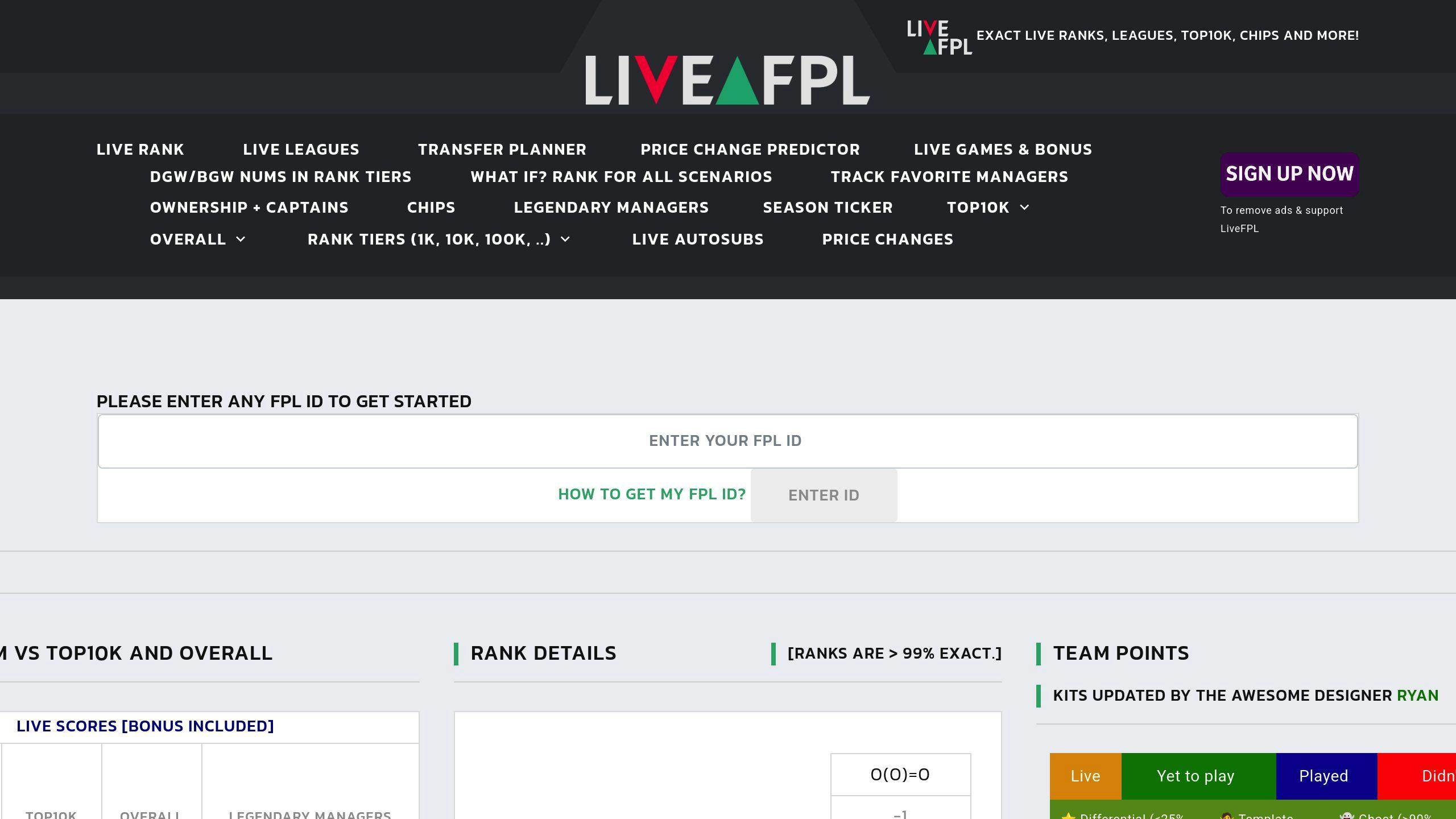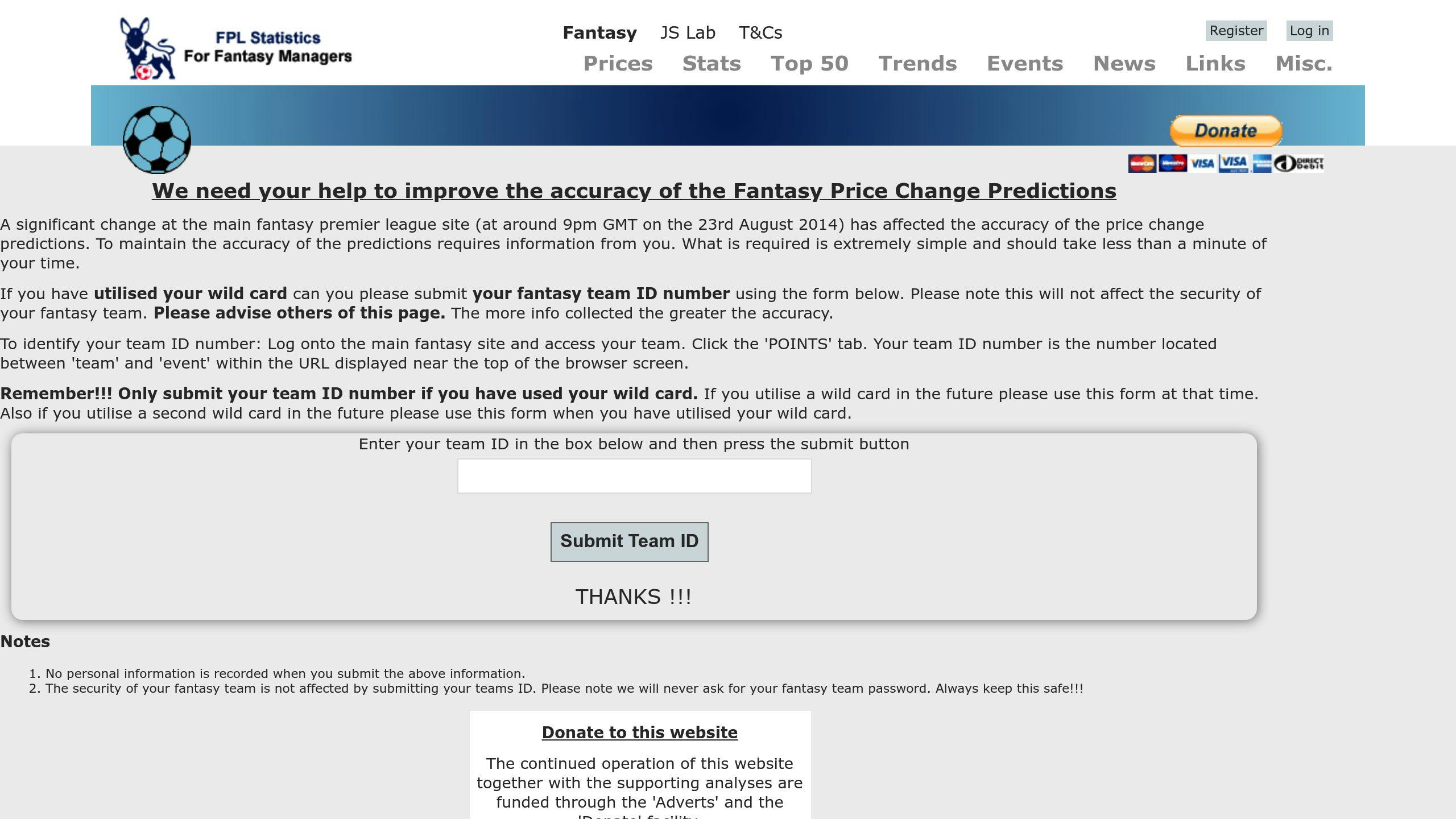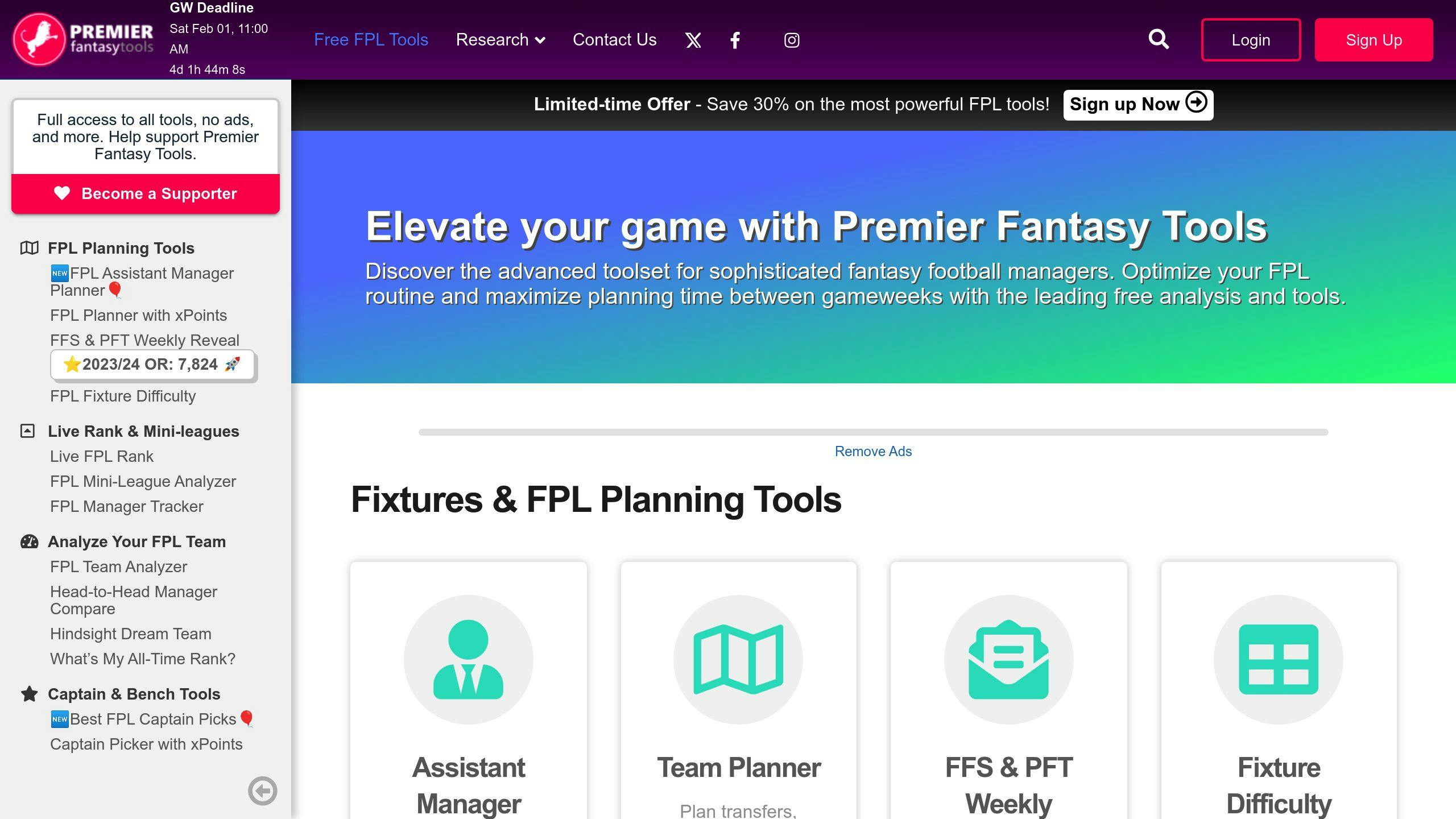Want to dominate Fantasy Premier League (FPL)? These 5 analytics tools can help you make better decisions with data-driven insights. From tracking player stats like expected goals (xG) to predicting price changes and live rank updates, these platforms are essential for FPL managers. Here’s a quick overview:
- FPL Review: Predicts player performance using machine learning and betting data. Features include transfer planning, live rank tracking, and fixture difficulty ratings.
- Fantasy Football Scout: Offers player projections, captaincy analysis, and a community forum for strategy sharing.
- LiveFPL: Real-time rank updates, bonus points tracking, and effective ownership insights during gameweeks.
- FPL Statistics: Focuses on ownership trends and predicts price changes to optimize transfers and team value.
- Premier Fantasy Tools: Combines analytics, fixture difficulty ratings, and multi-gameweek planning for a complete strategy toolkit.
Quick Comparison
| Tool | Key Features | Best For |
|---|---|---|
| FPL Review | Predictive models, transfer planning | Long-term squad planning |
| Fantasy Football Scout | Player projections, captaincy analysis | Comprehensive player insights |
| LiveFPL | Real-time updates, effective ownership | Live gameweek tracking |
| FPL Statistics | Ownership trends, price predictions | Transfer and value optimization |
| Premier Fantasy Tools | Multi-gameweek planning, fixture analysis | All-in-one strategy management |
These tools simplify complex decisions, helping you stay ahead in FPL. Let’s dive into their features and how they can improve your gameweek planning.
Is FPL Analytics King?
1. FPL Review

FPL Review is an analytics tool designed for Fantasy Premier League managers. It uses predictive models that combine machine learning and betting market data to estimate player performance [1]. Key features like the Team Planner and Transfer Suggestor allow users to plan transfers and manage squads with detailed predictions tailored to their timeline [1].
The platform also includes fixture difficulty ratings, which assess how upcoming matches might influence player performance. This helps managers make smarter decisions about their teams. Former FPL champion Simon March shared his thoughts on the platform:
"The Comparison Tool and Rate My Team tool came in very handy when trying to identify the relative strengths and weaknesses of my team when compared to those of my rivals." - Simon March, winner of FPL in 2014/15
FPL Review supports three planning strategies:
| Planning Method | Description |
|---|---|
| Single-Period | Focuses on the current gameweek |
| Multi-Period | Plans for several gameweeks ahead |
| Hybrid | Combines short- and long-term planning |
Both free and premium versions are available, with advanced tools like the Massive Data Planner accessible via Patreon [1]. Other features include the FT Value setting, which helps prioritize transfers for immediate or future gains, as well as live rank tracking and ownership trend analysis.
While FPL Review stands out for its predictive analytics, platforms like Fantasy Football Scout offer a wider variety of resources for FPL managers.
2. Fantasy Football Scout

Fantasy Football Scout is a platform designed to help Fantasy Premier League (FPL) managers make smarter decisions by combining data analysis with practical management tools. One of its standout features is the Expected Points Projections system, which uses algorithms based on historical data and predictive modeling. It evaluates key metrics like expected goals (xG) and expected assists (xA) to predict player performance.
The platform provides a variety of tools to refine your FPL strategy:
- Team Planner: Plan transfers across multiple gameweeks.
- Squad Optimizer: Uses AI to suggest team selections based on player form and upcoming fixtures.
- Fixture Analyzer: Helps with transfer and captaincy decisions by assessing fixture difficulty.
- Live Rank Tracking: Offers real-time updates to fine-tune your strategy.
For those who opt for premium membership, additional features are available, including the Team Optimizer and advanced player metrics to spot low-ownership players (differentials) and boost your points tally. The captaincy analysis tool is particularly useful, combining projected points, fixture difficulty, and ownership data to recommend the best captain for the week.
Fantasy Football Scout also fosters a strong community element. Active forums allow experienced managers to share advice and strategies, creating a collaborative environment that complements the platform's data-driven tools.
While there is free content available, serious FPL managers may find the premium features particularly helpful for maximizing their performance. Compared to other tools like FPL Review, Fantasy Football Scout offers a broader range of resources, but for real-time updates, LiveFPL remains a strong alternative.
sbb-itb-2e37f13
3. LiveFPL

LiveFPL takes FPL performance tracking to another level by offering instant updates on rank, bonus points, and substitutions - features that outpace the often-delayed updates of the official FPL site. Its Effective Ownership (EO) calculator is a standout tool, combining ownership percentages with captaincy choices to show a player's actual impact on your rank. This is especially helpful for managers looking to fine-tune strategies during active gameweeks.
The mobile app adds even more value, offering real-time tracking of bonus points, substitutions, and mini-league ranks. Push notifications for scoring events ensure you stay updated without constant checking. Plus, the Live Scorecard feature provides a clear view of live scoring events, helping you better assess your team's performance as it unfolds.
Ranking System Breakdown
LiveFPL’s ranking system offers three types of updates:
| Rank Type | Description |
|---|---|
| Standard Rank | Updates in real-time but excludes auto-substitutions. |
| Projected Rank | Includes predicted auto-substitutions for a more accurate live ranking. |
| Final Rank | Aligns with the official FPL rank at the end of the gameweek. |
What sets LiveFPL apart is its ability to deliver instant rank updates and EO insights during gameweeks, helping managers spot trends and uncover differentials. This gives you the tools to make quicker, more informed decisions for a competitive edge.
While platforms like Fantasy Football Scout focus on in-depth player analysis, and Fantasy Football Hub provides planning tools, LiveFPL shines in offering real-time updates and immediate feedback. On the other hand, tools like FPL Statistics are better suited for tracking transfer market trends and price changes, making LiveFPL the go-to option for staying ahead during active gameweeks.
4. FPL Statistics

FPL Statistics focuses on analyzing ownership trends and predicting price changes, offering tools designed to help managers refine transfers and maintain team value. Its standout feature is its detailed ownership analysis, especially among the top 100k managers, which provides insights into player impact across various ranking tiers.
Key Features and Tools
FPL Statistics combines two main tools to support Fantasy Premier League (FPL) managers:
Ownership Analysis
- Tracks ownership trends among top-ranked managers.
- Highlights potential differential players and those with high impact.
- Helps predict rank shifts based on ownership data.
Price Prediction System
- Analyzes transfer activity to predict price rises and falls.
- Particularly useful during busy transfer periods, like double gameweeks.
- Aids in preserving and growing team value.
The Squad Optimization Tool takes it further by blending fixture difficulty ratings with ownership data. This tool suggests transfer moves that align with both short-term and long-term team strategies, helping managers stay ahead.
What makes FPL Statistics different from platforms like LiveFPL is its emphasis on long-term ownership trends rather than just live gameweek updates. While LiveFPL is great for real-time stats, FPL Statistics provides insights that guide transfer planning across several gameweeks.
Although FPL Statistics stands out in ownership and price trend analysis, platforms like Premier Fantasy Tools offer a more extensive range of features for comprehensive gameweek planning.
5. Premier Fantasy Tools

Premier Fantasy Tools brings together a range of features in one place, offering a well-rounded platform for FPL gameweek planning. It combines detailed analytics with practical management tools, making it a go-to option for FPL managers.
Key Features and Insights
This platform blends advanced analytics with fixture analysis to help users plan effectively. Its Expected Points Projection tool predicts player performance using xG (expected goals) and xA (expected assists) metrics. The Multi-Gameweek Planning Interface allows managers to:
- Plan transfers for the entire season
- Create multiple team drafts for different scenarios
- Strategize chip usage timing
- Monitor live rank changes during gameweeks
The built-in FDR (Fixture Difficulty Rating) system analyzes match difficulty across gameweeks, helping users fine-tune their transfer strategies, chip usage, and long-term plans. This alignment of short-term decisions with season goals makes it a useful tool for serious managers.
Tracking Performance and Accessibility
Premier Fantasy Tools also excels in performance tracking, using advanced metrics to spot trends before they gain traction in the FPL community. It’s accessible via web browsers and dedicated mobile apps (available on the App Store and Google Play), so managers can make quick decisions and monitor live performance anytime, anywhere.
The live rank tracking feature gives instant feedback, helping managers adjust strategies as needed. Unlike tools such as FPL Statistics, which focus on price changes and ownership trends, Premier Fantasy Tools offers a broader range of features for FPL management.
With its mix of analytics, planning tools, and real-time tracking, Premier Fantasy Tools is a strong choice for managers looking for a complete gameweek planning solution.
Conclusion
Using FPL analytics tools has become a game-changer for Fantasy Premier League managers aiming to stay ahead of the competition. These platforms provide data-driven insights that help managers make smarter decisions throughout the season.
Making the Most of Analytics Tools
Combining key metrics from various tools can give you an edge. For example, using xG/xA data to spot under-the-radar players and fixture difficulty ratings to plan transfers across multiple gameweeks. Tools like FPL Review for xG/xA stats and Fantasy Football Scout for fixture analysis can work together to shape better transfer and captaincy strategies.
"I prefer to use data to cut through the noise", says Paul Solomon, a manager with four top 1% finishes in the last seven seasons, highlighting the power of a data-driven approach.
Putting Insights into Action
Once you've chosen your go-to tools and metrics, the next step is weaving them into your weekly FPL routine. Dedicate time to review stats, factor in updates like injuries or team news, and map out strategies for upcoming gameweeks using platforms like Premier Fantasy Tools.
Keep in mind that these tools are guides, not gospel. The best managers use analytics to inform their decisions while staying flexible enough to adjust to unexpected changes during the season.
